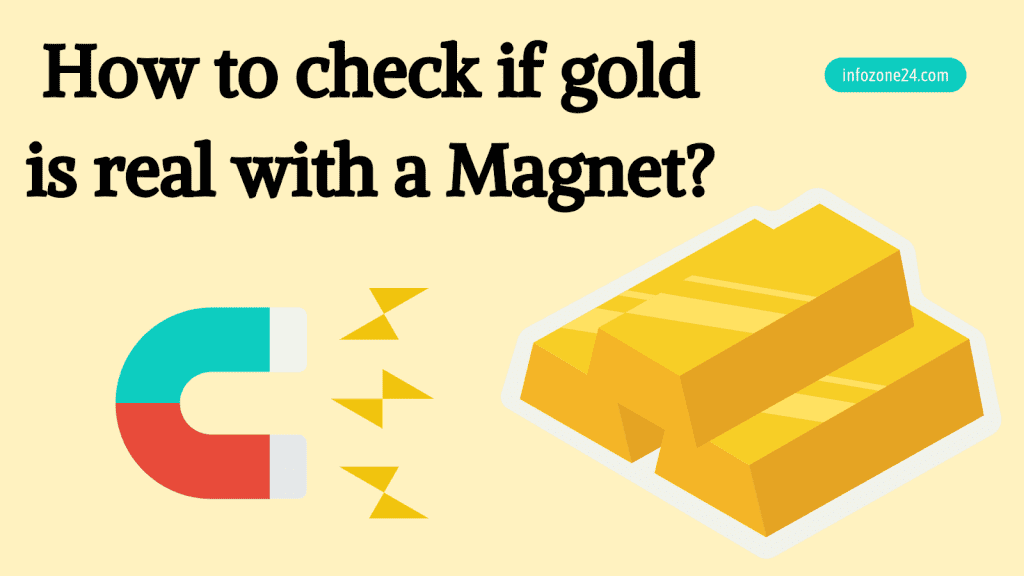When you are considering buying gold jewelry, you probably have a nervous feeling that whether the gold being sold to you is real or not. Determine the authenticity of your gold to make sure that you’re getting the exact value for which you’re paying. Keep reading to find out everything you need to know about, “How to check if gold is real with a magnet?”
How To Check If Gold Is Real With A Magnet
The authenticity of gold can be checked with a magnet by determining if the gold in question responds to the magnetic force. Since gold is a non-magnetic metal, it is easy to tell if it is not real based on its reaction to the magnetic force of a magnet.
What Do You Need?
- A strong magnet (Neodymium magnet)
- The gold in question
- Metallic objects (Paper clips, needles, or nails)
The Magnet Test:
Thanks to the fact that real gold is not magnetic, the response to a magnetic force would be a clear exhibition that the gold is not real or mixed with some other metals. Follow these steps for the magnet test:
- Make sure that the magnet is working correctly. Test it with metallic objects, like nails, needles, or paper clips.
- Clean your gold item properly. For getting accurate results, make sure there’s no dirt, shards, or grunge.
- Place the gold in question on a clean wooden surface.
- Take the magnet and slowly bring it close to the gold piece.
- Note the reaction of your gold item caused by the magnet.
Size Of The Magnet And Gold In Question:
The proper sizes of both the magnet and the gold in question are important for this test to be successful. Here are some tips for the sizes of both:
- For the most accurate results, the size of the gold in question must be equal to or smaller than the magnet.
- The magnet must be strong enough to pull the gold item.
- A bigger magnet is recommended for this test because it will be more powerful and strong.
- A smaller magnet will not be able to create a magnetic reaction with heavier gold items like gold bars.
- Never use regular refrigerator magnets. These cannot provide the needed magnetic field to detect magnetic metals in the gold in question.
Keep Reading: Is Recycled Gold Better Than Mined?
Results Of The Magnet Test:
The entire magnet test consists of placing your gold item on a clean wooden surface and taking the magnet into your hand. You need to move the magnet slowly to the surface of the gold in question without touching it.
- If the gold is pulled towards the magnet or vice versa, the gold contains traces of other metals. It is not real gold.
- On the other hand, if the gold does not show any reaction to the magnetic force, your gold item may be made of real gold.
Drawbacks Of The Magnet Test:
This test is not an ultimate test to check the authenticity of gold.
- Sometimes, fake gold contains non-magnetic metals, like brass and copper. These metals don’t show any reaction to the magnetic force. This doesn’t mean that the gold is real.
- Some gold alloys have traces of magnetic metals. Like iron and nickel. While testing these alloys with magnets, they respond to the magnetic force. These alloys contain pure gold with a few impurities. So, showing a response toward a magnetic field does not make them fake gold.
- Also, sometimes magnetic strength pieces like metal claps, metal springs, or bracelet wires are connected to pure gold items. These magnetic parts can be attracted to the magnetic force. This doesn’t mean that the whole thing is made of fake gold.
So, we can say that the magnet test is not a guaranteed test for checking the authenticity of gold.
Keep Reading: Which Company is Best to Sell Gold in 2023?
FAQs
White gold is an alloy that contains pure gold and some other metals. Its attraction to a magnet depends upon metals other than pure gold. If other metals are magnetic (like copper and palladium), the white gold becomes magnetic. If other metals are non-magnetic (like nickel and zinc), white gold remains non-magnetic.
24K gold is 100% pure gold. Pure gold is non-magnetic metal. So, 24K gold can never be drawn to a magnet. Other than 24K gold, all karat levels are impure. 10K, 14K, and 18K, all of them can be magnetic. These gold alloys contain metals that can be attracted to magnets.
Iron, nickel, and cobalt are commonly used in counterfeit gold. Having a similar density to gold, these metals are suitable for counterfeiting it. Sometimes, these metals have only a thin gold plating.
Conclusion:
So, that was everything about, “How to check if gold is real with a magnet?” The magnet test is not foolproof. If you are not satisfied with the results, you can always consult a professional jeweler.
Read Now: How to Check If Gold is Real With a Lighter & 18 Other Methods
Michael C Vang is a passionate blogger. He has been blogging since 2013 on a variety of topics. He is committed to creating informative and engaging content that helps readers learn more about everything.



